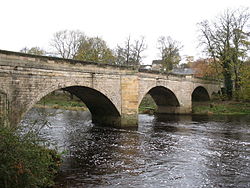Boston Spa
| Boston Spa | |
|---|---|
 Thorp Arch Bridge |
|
| Boston Spa shown within West Yorkshire | |
| Population | 4,079 (2011) |
| OS grid reference | SE431455 |
| • London | 170 mi (270 km) SSE |
| Civil parish |
|
| Metropolitan borough | |
| Metropolitan county | |
| Region | |
| Country | England |
| Sovereign state | United Kingdom |
| Post town | WETHERBY |
| Postcode district | LS23 |
| Dialling code | 01937 |
| Police | West Yorkshire |
| Fire | West Yorkshire |
| Ambulance | Yorkshire |
| EU Parliament | Yorkshire and the Humber |
| UK Parliament | |
Boston Spa is a village and civil parish in the City of Leeds metropolitan borough in West Yorkshire, England. Situated 3 miles (5 km) south of Wetherby, Boston Spa is on the south bank of the River Wharfe which separates it from Thorp Arch. According to the 2001 census the parish had a population of 4,006 rising to 4,079 in the 2011 census.
In 1744, John Shires established a spa town when he discovered sulphur springs in the magnesian limestone. It was known as Thorp Spa but declined when Harrogate became very popular as a spa town.
In 1753, a turnpike was built on the Tadcaster to Otley road, which passes through Boston Spa. In the same year, Joseph Taite built a house to accommodate visitors that became the Royal Hotel, which is still standing, but converted into flats and shops. By 1819, Boston Spa had a population of more than 600, and several inns and other houses offering accommodation had been built . Spa baths were built to allow visitors to take the waters. On the north bank of the river is the village of Thorp Arch, which predates Boston Spa by several centuries.
The Boston Spa and Thorp Arch Conservation Area, designated in 1969, extended across both Boston Spa and Thorp Arch parishes. It was revised in 2009, restricting the boundaries to Boston Spa parish and reshaped to exclude areas of late-20th-century estate housing to the south of the High Street. The current conservation area boundary focuses on the historic settlement. It was extended to the west, to encompass West End, an area of dwellings constructed during the Second World War to house workers from Thorp Arch munitions factory. The war had a major effect on Boston Spa's population, society and surroundings, and the buildings stand as a testament to that history.
...
Wikipedia

